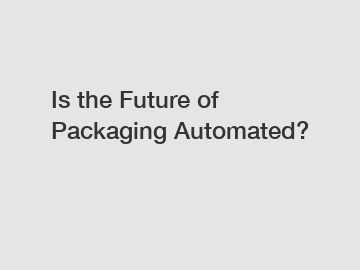Is the Future of Packaging Automated?
With the rapid advancements in technology and the increasing focus on sustainability, the future of packaging is moving towards automation. Automation in packaging can help streamline processes, increase efficiency, reduce waste, and ultimately create a more sustainable and cost-effective supply chain.
One of the main drivers of automation in packaging is the need for increased efficiency and productivity. With the rise of e-commerce and the demand for faster delivery times, companies are looking for ways to speed up their packaging processes. Automated packaging solutions can help companies meet these demands by reducing the time it takes to package products and get them out the door.
Automation can also help reduce the amount of waste generated during the packaging process. By using precise measurements and cutting techniques, automated packaging systems can help companies minimize the amount of excess material used in packaging. This not only reduces waste but also helps companies save money on materials and transportation costs.

Another benefit of automation in packaging is the ability to customize and personalize packaging for each individual product. With automated systems, companies can easily switch out packaging designs and sizes to accommodate different products, without causing disruptions to the production line. This allows companies to create unique and eye-catching packaging that can help attract customers and stand out on crowded retail shelves.
In addition to increasing efficiency and reducing waste, automation in packaging can also help companies meet sustainability goals. By using less material and producing less waste, companies can reduce their environmental impact and appeal to eco-conscious consumers. Automated packaging solutions can also help companies track and monitor their packaging processes, allowing them to identify areas for improvement and implement changes that can help reduce their carbon footprint.
While automation in packaging offers many benefits, it also presents some challenges. One of the main challenges is the initial cost of implementing automated packaging systems. Companies need to invest in new equipment, technology, and training to transition to automated packaging, which can be a significant upfront cost. However, the long-term savings and benefits of automation typically outweigh the initial investment.
Another challenge of automation in packaging is the potential impact on jobs. As more companies adopt automated packaging systems, there is a concern that traditional packaging jobs may be at risk. However, automation in packaging also creates new job opportunities, such as technicians and engineers who specialize in maintaining and operating automated systems.
Overall, the future of packaging is undoubtedly moving towards automation. With the increasing demand for efficiency, sustainability, and customization in packaging, companies are turning to automated solutions to meet these needs. By investing in automated packaging systems, companies can streamline their processes, reduce waste, and create unique and eye-catching packaging that appeals to consumers. While there are challenges to overcome, the benefits of automation in packaging are clear, and companies that embrace this technology will be well-positioned for success in the future.
For more information, please visit Small EPS foam molding machine, EPE foam sheet machine suppliers, jerrycan blow molding machin.


